
Last week we saw how the essential elements of European civilization survived through some 700 years of regime change and barbarism. Sir Kenneth Clark now describes the sudden (re)awakening of European civilization in the 12th century. He sees this as a pivotal moment in human history and explores its roots in Christianity, traces it from its first manifestations in the Cluny Abbey to the Basilica of St Denis, and onto its high point, the building of Chartres Cathedral in the early 13th century.
___________________________
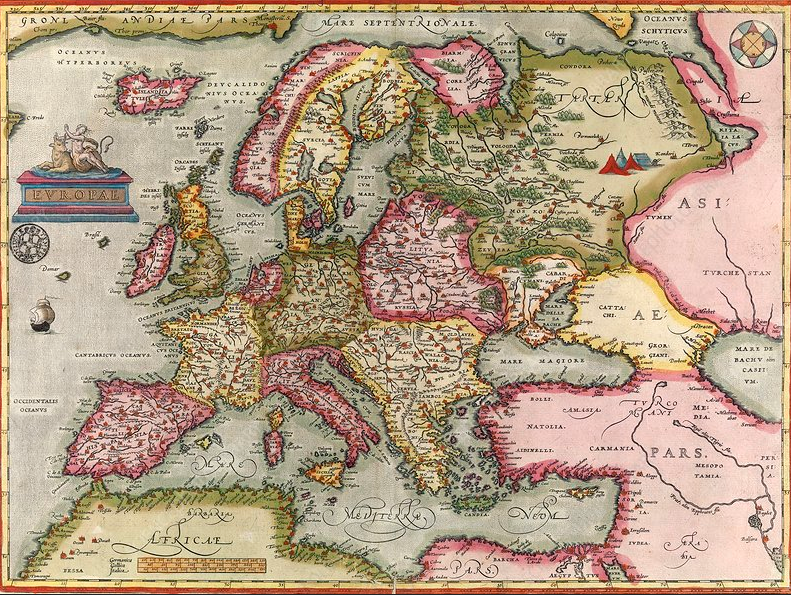
THE TWELFTH CENTURY RENAISSANCE
The Great Thaw: Clark goes to great lengths to emphasise the extraordinary intellectual and cultural upheaval that characterized the 12th century in Europe:
There have been times in human history when the earth seems suddenly to have grown warmer or more radio-active. Three or four times in history humanity has made a leap forward. One such time was around the year AD1100 and the most dramatic effect was in Western Europe. In every branch of life – action, philosophy, organization, and technology – there was an extraordinary outpouring of energy, an intensification of existence. Popes, emperors, kings, bishops, saints, scholars, philosophers were all larger than life, and the incidents of history are great heroic dramas or symbolic acts that still stir our hearts.
Cultural Revolution: As the historian, Charles H. Haskins, observed in The Renaissance of the 12th Century (1957, p.viii):
[This was] an age of fresh and vigorous life. The epoch of the Crusades, of the rise of towns, and of the earliest bureaucratic states of the West, it saw the culmination of Romanesque art and the beginnings of Gothic; the emergence of the vernacular literatures; the revival of the Latin classics and of Latin poetry and Roman law; the recovery of Greek science, with its Arabic additions, and of much of Greek philosophy; and the origin of the first European universities. The 12th century left its signature on higher education, on the scholastic philosophy, on European systems of law, on architecture and sculpture, on the liturgical drama, [and] on Latin and vernacular poetry.
Sudden Confidence: Clark emphasizes how quickly and abruptly this transformation occurred – in only 50 years or a single lifetime – and how it implied a new social and intellectual background, wealth, stability, and technical skill. Above all, it required confidence in the future that made long-term projects worthwhile.

THE CENTRAL ROLE OF THE CHURCH
Triumph: To explain this cultural upsurge, Clark highlights “the triumph of the Church,” which saw thousands of monasteries established (1200 in France alone) and many awe-inspiring cathedrals erected. So influential was the Church that “it could be argued that Western Civilisation was basically the creation of the Church.” Several reasons can be identified for its prominence:
1/ It was the ‘Church Militant’, the one power on earth confronting the forces of darkness.
2/ Churches invariably dominated their localities and communicated massive spiritual power.
3/ The “inconceivable splendour” of its great cathedrals and monasteries had an overwhelming emotional impact on people.
4/ It inspired and directed people’s intellectual and emotional lives.
5/ It was a meritocracy, attracting people of intellectual ability and ambition who could rise according to their talents.
6/ It was an international organization.
7/ Over time, it accumulated a great deal of property, assets, and wealth and was not weakened by divided inheritances.
Cluny: “This expansion of the human spirit was first made visible in the Abbey of Cluny [which] became the greatest church in Europe, not only a huge complex of buildings, but a great organization and benevolent power in Church politics.”
Tragically, almost nothing of this immense complex or of its rich contents remains today.
Irrepressible Energy: What drove the Cluniac style (as illustrated above) of brightly painted sculpture and decoration, with its “sharp cutting, swirling drapery, twisting lines, and restless impulses”? Perhaps these were attempts to express important philosophical and theological ideas, or to represent musical tones. But above all, for Clark,
the invention which boiled over into sculpture and painting in the early 12th century was self-delighting … The motive force behind them was simply irrepressible, irresponsible energy. The Romanesque carvers were like a school of dolphins.
Cowering Mortals: Clark points out the mullion of the church of Souillac – “one of the most bizarre and terrifying works of art ever produced in Western Europe” – with its“gigantic birds with evil-looking beaks, and cowering mortals”. It is “an epitome of forest fears, a kind of totem-pole of Western man at the end of his wanderings.” And what has it do with Christian values, Clark asks, noting the great St Bernard of Clairvaux’s condemnation of these “monstrosities”?(In fact, they had a great deal to do with the firm contemporary belief in the absolute reality of Satan, his demons, and the horrors of Hell to which they wished to drag sinful human beings. It was to escape such a fate that wealthy people endowed monasteries and purchased relics to which they might pray for deliverance.)
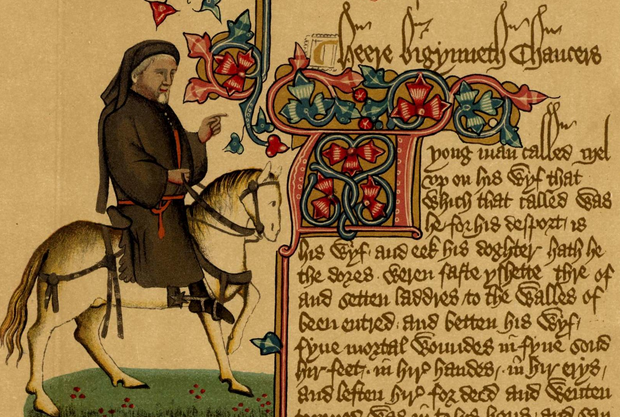
PILGRIMAGES & IDEAS
Clark acknowledges that the all-pervasive monastic ideal focused on
an ideal of eternity and that is an important part of civilisation.” However, “the great thaw of the 12th century was achieved by action ~ a vigorous, violent sense of movement, both physical and intellectual:
1/ Pilgrimages & Crusades: In the realm of the physical, movement was exemplified by pilgrimages and the Crusades. Both were forms of penance, both involving arduous journeys to holy sites, to visit relics and seek the intercession of saints, and/or reclaim the site for Christianity. An excellent example of a pilgrimage was that to the town of Conques to visit the relics of St Foy (St Faith), a young girl martyred for her beliefs. And, of course, Jerusalem was the premier destination, for both pilgrims and crusaders. Clark suggests that the Crusades unleashed a “turbine of creative energy” composed of “northern rhythms and oriental motives … tugging at the carcass of Greco-Roman art” that expressed itself in the Romanesque style.
2/ A Play of Minds: In the realm of ideas there was this same “feeling of tugging, of pulling everything to bits and re-shaping it.” Clark believes
the main structure, the Christian faith, was unshakable. But around it was a play of minds, a tugging and a tension, that has hardly existed since.”
He suspects that this intellectual dynamism
prevented Western Europe from growing rigid, as so many other civilisations have done.
Paris & Abelard: In this “age of intense intellectual activity”, nowhere was more important than Paris. Indeed, “what was going on in Paris about the year 1130 makes one’s head spin.” Central to this was “the brilliant, enigmatic figure of Peter Abelard, the invincible arguer, the magnetic teacher,” who declared not, “I believe in order to understand,” but, “I must understand in order to believe.”
Abelard became the subject of immense controversy (and was targeted by St Bernard), centred not only on his relentless (‘deconstructionist’) dialectical theology, but on his torrid and notorious love affair with the lady Heloise and the tragedy (and release) it brought to them both.
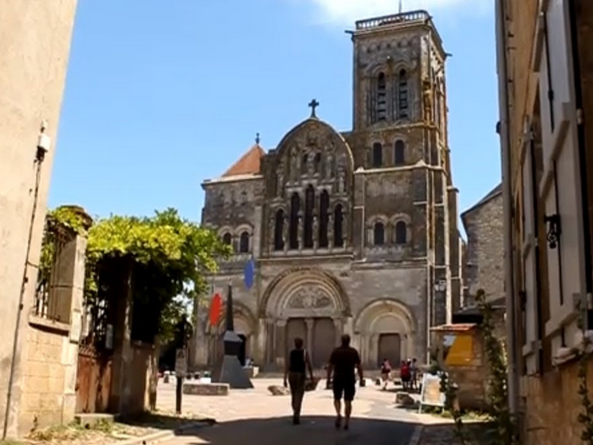
VÉZELAY
Taking the Cross: Clark introduces the Cluniac Abbey of Vézelay (above), Burgundy, where St Bernard preached the Second Crusade in 1146, prompting Louis VII of France, his wife, Eleanor of Aquitaine, and the princes and lords present to prostrate themselves at Bernard’s feet and take the Cross.
Harmony: Clark felt the Abbey’s architectural harmony must have nurtured a sense of worship and contemplation. Indeed,
I can think of no other Romanesque interior that has this quality of lightness, this feeling of Divine Reason.
He believes it signalled a shift from the Romanesque into “a beautiful early Gothic.” The Gothic style would come to dominate architecture until the Renaissance.
From Romanesque to Gothic: Advances in design made it possible to open up churches and cathedrals, using such devices as pointed (vs. round) arches; groin (vs. barrel) vaults; flying buttresses (vs. thick walls); vertical, soaring height (vs, horizontal squat shape); large, even massive windows, with lots of stained glass (vs. small windows); light airy (vs. dark, gloomy) interior.
Gislebertus: Clark laments that “we don’t know the name of the architect at Vézelay”. However, he points out that we do have the name of the builder of the cathedral at Autun ~ a master-mason called Gislebertus, who decorated the entire building between c.1125-35. Clark discusses his sculptures and carvings, focusing on his depiction of the Last Judgement. He finds there a sensitive human narrative combined with a “taste for horrors.” He points out that Gislebertus “also did a figure of Eve which is the first female nude since antiquity to give a sense of the pleasures of the body.”
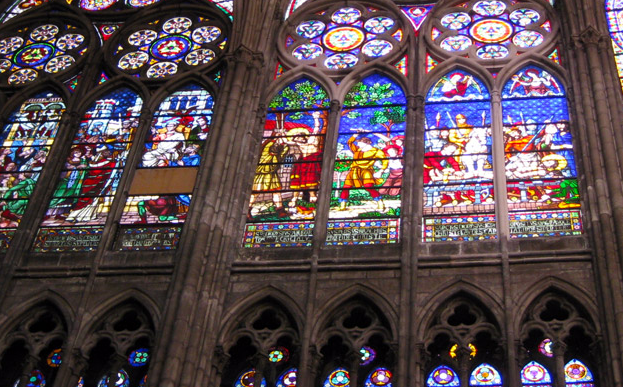
SUGER & THE ABBEY OF ST DENIS
Abbot Suger: The origins of the Gothic style concerns Clark for the bulk of the rest of Episode 2. The key figure here is Suger (1081-1151), the Abbot of the royal abbey of St. Denis (above) in northern Paris, where the relics of Denis, a patron saint of France, were interred in 636, and where all the kings of France were buried. Suger had been given as an oblate to the abbey at the age of ten, and he rose to become Regent of France, a statesman and confidante of kings. He became the sponsor and principal inspiration behind the original Gothic style. Fortunately, he left behind a detailed account of the transformation of St Denis into an early Gothic masterpiece, undertaken under his direction.
Philosophical Basis: Suger’s work “had a philosophical basis that is very important to western civilisation,” derived from the theology of a mysterious Christian theologian and philosopher of the 5th/6th centuries, who represented himself as Dionysius the Areopagite, the Athenian convert of Paul the Apostle (Acts 17:34). This claim was accepted up until the Renaissance and gave his work enormous authority, fundamentally shaping the direction of theology and mystical speculation. His most important works include The Celestial Hierarchy, which concerns the structure of creation; and Mystical Theology, which concerns the via negativa, and the soul’s ascent to God.
Light & the Ascent to God: Suger collected many beautiful items as a tribute to “the glory of God.” He had a great love of beauty and was fascinated by the idea that the beauty inherent in the material realm – especially in the play of light – opened a portal to the Divine. Consequently, he emphasized two themes from the thought of Pseudo-Dionysius: the role of light, and the concept of the soul’s ascent towards God. As Clark points out
Suger argued that we could only come to understand absolute beauty, which is God, through the effect of precious and beautiful things on our senses. He said: ‘The dull mind rises to truth through that which is material’.
Revolutionary Conception: This involves the spiritualisation of matter:
This was really a revolutionary concept in the Middle Ages. It was the intellectual background of the sublime works of art of the next century and has remained the basis of our belief in the value of art until today.
Stained Glass: It seems Suger largely invented the Gothic style, notably the pointed arch, flying buttresses, clerestory windows, and the rose window, making revolutionary use of stained glass to infuse Christian concepts and narratives with brilliant light. Sadly, much of this has been destroyed.

CHARTRES CATHEDRAL
Divine Harmony: Clark therefore turns to Chartres Cathedral (above) to get a better impression of the Gothic style. Once again he notes the great harmony of the structure:
Chartres was the centre of a school of philosophy devoted to Plato, and in particular to the Timaeus, from which it was thought that the whole universe could be interpreted as a form of measurable harmony.
Contrasts: Clark pays particular attention to the main portal of Chartres, where he notes many moving incidents carved by a master who probably worked for Suger at St Denis. He believes he drew his inspiration from “early Greek sculpture in the south of France,” and sees him as an excellent representative of civilisation. However, Clark contrasts the portrayal of human faces in the portal with classical depictions of gods and heroes: the latter display arrogance, brutality and soullessness, while the contemporary faces reveal refinement. Indeed,
the look of selfless detachment and the spirituality of these heads is something entirely new in art.
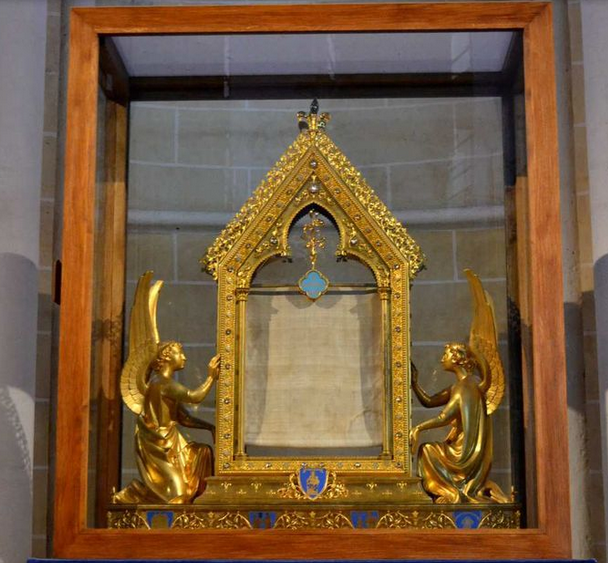
THE VIRGIN MARY
Seismic Shift: Chartres contained a famous relic, the actual tunic Mary (above) wore at the time of the Annunciation, and it was believed by the faithful to be a special abode of the Holy Mother, and for this reason they laboured mightily to help build and repair the cathedral in its early decades. This devotion reflected a seismic shift in the religious consciousness of Europe. Before Chartres, “the virgin played a very small part in the minds of people”, but “after Chartres the greatest churches in France were dedicated to her.” The feminine aspects of the Divine had moved to centre stage.
Causes? Clark suspects that this shift reflected the cultural and psychological impact of the Crusades, as “the returning warriors brought back an admiration for the womanly virtues of gentleness and compassion.” He also notes the influence of St Bernard, “one of the first men to speak of the Virgin as an ideal of beauty and a mediator between man and God.” Later, in the Paradiso, Dante produced “a hymn to the Virgin which I think one of the most beautiful pieces of poetry ever written.”
THE BRIDGE
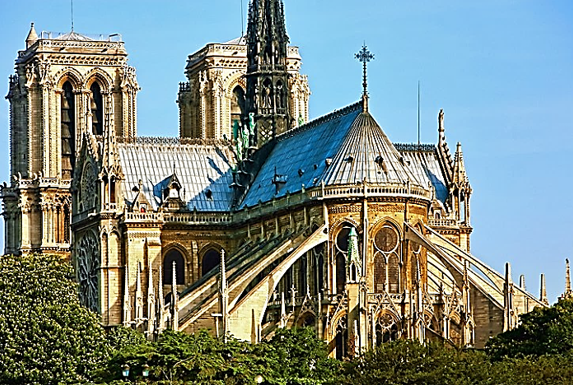
The flying buttresses of Notre Dame
Ultimately,
Chartres was the bridge between Romanesque and Gothic, between the world of Abelard and Aquinas, the world of restless curiosity and the world of system and order.
It epitomized the first great awakening in European civilisation and provided its foundation:
its sense of unity, its intellectual energy, its ability to move and change, its belief that the divine may be approached through beauty, and its sense of the unity.
All this and much more “appeared in those hundred marvellous years between the consecration of Cluny and the Rebuilding of Chartres.” The door was opened to the exalted world of the High Gothic, as we will see next week.
____________________________
APPENDIX: EUROPE AT THE END OF THE DARK AGES
Backwater: Around 1000, Europe was a backwater — a sparsely populated, thickly forested, swampy and mountainous peninsular on the north-western corner of the immense Eurasian continent. Politically, it consisted of many independent, class-ridden kingdoms and duchies, and although the Holy Roman Emperor ruled Germany, Burgundy, and northern Italy, he had no authority over France, England, or Spain, which had been colonized by Islam. Economically, it was dependent upon agriculture and an oppressed peasantry. Militarily, it was dominated by the knightly caste – wild, unpredictable warriors who were a law unto themselves, and committed to a code of honour and vengeance that knew only violence as a solution to all disputes. Culturally it was bound together by the sacramental theology of medieval Christianity, which promised deliverance from the ever-present threat of Hell, and salvation before the looming Apocalypse and the menace of the Antichrist.
Rapine: To the north were the bitterly cold, inhospitable Arctic lands, whence the Vikings launched countless raids, plundering, raping, enslaving, and killing all within reach of their long ships. To the west and north-west was the vast Atlantic, which no man had crossed and returned to tell the tale. To the north-east were the pagan lands around the Baltic; while to the east and above the Black Sea lay the mysterious realm of the Rus, centred on the city of Kiev. This hostile region had only recently adopted the Eastern Orthodox form of Christianity and served as a buffer state, blocking the expansionist forces of Islam to the south, and restraining the marauding hordes on the Eurasian steppes that had periodically devastated what civilization there was.
Mediterranean: In the south, most of Iberia was in Muslim hands, after a phenomenal period of conquest had brought Islam across the Pyrenees and into the heart of France before it was defeated by Charles ‘The Hammer’ Martel at Poitiers in 728. Italy remained favourably placed for trade as a promontory in the Mediterranean, once serving as a great lake completely encompassed by the mighty Roman Empire, under which it had been criss-crossed by innumerable trade routes along which civilization had developed for a thousand years.
Fall of Rome: Those prosperous days were long gone. Islam now lay across the lucrative trade routes to the East, while Rome had sunk centuries before into cultural decadence before imploding under the impact of plagues, natural disasters, and economic dislocation. This saw the population of the Empire drop from about 70 million to 50 million between 150 and 400, a decline of almost 30%. This disaster was accompanied by repeated invasions of rapacious barbarian masses that broke in massive waves on the fragile borders of the Empire, only half-defended by an army of doubtful loyalty and effectiveness.
Deserted: This fabled ‘Fall of the Roman Empire’ had left the tribes, peoples, and proto-nations of Western Europe to fend for themselves through the Dark Ages. Deserted by Rome, the population of Britain dropped from the million that had lived there under the Empire to less than 500,000 by 750. The population of Gaul was also halved, from 6 million to 3 million. In some parts of Italy, 75 per cent of the urban areas were abandoned after decades of war, and peasants wandered amidst the immense ruins of Rome, wondering about what alien race could possibly have created such a marvel.
The Extreme Weather Event of 535–536: The Dark Ages had been characterized by a serious of major natural disasters. First to be noted must be the extreme weather event of 535–536. This involved the most severe and protracted short-term episode of cooling in the Northern Hemisphere in the last 2000 years. Its effects were widespread, causing unseasonably cold weather, massive crop failures, widespread famines, and major population disruption across Eurasia, from China to Ireland.
The Late Antique Little Ice Age: This seems to have involved the a series of cataclysmic volcanic eruptions that occurred in 536, 540 and 547, and together triggered what is now known as the Late Antique Little Ice Age. This lasted from 536 until 660 and prolonged the climate crisis that afflicted much of the rest of the world through the Dark Ages.
Cause: The event is thought to have been caused by an extensive dust veil across the upper atmosphere, probably resulting from a colossal volcanic eruption in the tropics, or possibly a meteor or comet strike on the Earth’s surface. (A likely candidate as the cause of this extreme event was proposed by David Keys in Catastrophe: A Quest for the Origins of the Modern World (1999), which pointed out that the Indonesian volcano, Krakatoa, exploded at the time. This caused global climate chaos and initiated major historical change on a continental scale.)
The Plague of Justinian: These climatic upheavals profoundly disturbed the ecological systems governing the occurrence of plague across the Eurasian landmass. This prompted a mass migration of plague-carrier animals, e.g., rats, out of China and into western zones that possessed limited or zero resistance to the disease. This produced the Plague of Justinian (541–542), one of the deadliest pandemics in history, killing between 25 and 50 million people worldwide, perhaps up to a quarter of the world’s population.
Islam: The rise of Islam in the following century is one of the most extraordinary phenomena in history. A rigorous monotheism, it emerged in Western Arabia and was based on the declaration that God is One and Muhammad was his prophet, and upon the Five Pillars: that declaration, regular daily prayer, alms-giving, fasting during Ramadan, and a pilgrimage to Mecca. In a matter of decades after the death of Muhammad in 632 it defeated the two dominant empires in its region: Byzantium and the Sasanian Empire of Persia (after they had virtually destroyed themselves in war). It then expanded across three continents, with Muslims establishing themselves as a ruling class across a vast swath of territory from Spain and Morocco to India. The great cities of the Middle-East, including Damascus, Baghdad, Cairo, and Jerusalem, were all conquered within a decade or so, with Jerusalem having special significance as it was revered as the place where Muhammad ascended into Heaven. By 700 the two Christian strongholds of France in the West and Constantinople in the East were facing the sharp horns of the Muslim crescent.
People of the Book: Conquered pagans had to convert to Islam or be executed, but Christians and Jews, as adherents of ‘superseded’ Abrahamic religions were considered ‘People of the Book’ and tolerated in a subordinate state, as dhimmis. They were always to be subservient to Muslims, could not ride on horseback or bear arms, but they were allowed to practice their own religions as long as they did not try to convert anyone and paid a special tax as a sign of their submission to Islamic rule.
Fractured Unity: But then the unity of Islam fractured, as two great, fiercely antagonistic sects emerged. Sunni Islam reigned in the north under the Abbasid caliphate based in Baghdad, while Shi’a Islam dominated the south under the Fatimid caliphate based in Cairo. Moreover, the Arab and Persian dominance was then challenged by the Seljuk Turks, a nomadic people that had emerged from the Eurasian Steppes. These energetic people eagerly embraced Sunni Islam, overran Mesopotamia, and seized control, with their leader taking the title ‘Sultan’ (Ruler). By 1095 they controlled Iran, Iraq, Syria, and Palestine and were menacing the Fatimids in Egypt, as well as increasingly dominating Anatolia and threatening Constantinople after their victory at Manzikert.
The Muslim View of the West: Muslims in the 11th century had remarkably little interest in the world of Christendom, apart from Byzantium. This they knew as the land of Rüm (Rome), whose people were devoted to a religion superseded by Islam, and which they saw simply in terms of its military capacity to resist the encroachment of Islam. The distant Western Europeans were regarded by Muslims as barely human.
More Like Beasts Than Men: Europe was seen by enlightened Muslims as the home of men that were little better than beasts. As one contemporary Islamic scholar reported:
“They are more like beasts than like men … their bellies gross, their colour pale, their hair long and lank. Thus they lack keenness of understanding and clarity of intelligence, and are overcome by ignorance and apathy, lack of discernment, and stupidity.” (quoted: Bernard Lewis, The Muslim Discovery of Europe, 1982, p.68.)
The Islamic Golden Age: This condescension arose because the 11th century was the mid-point of the ‘Islamic Golden Age’ (c.750-1250). During this period the Islamic world witnessed comparatively high levels of economic, cultural, and scientific development, building upon the Classical intellectual inheritance of ancient Greece and Rome, a knowledge of which was preserved in the Muslim lands while it was largely lost in Europe after the collapse of the Roman Empire in the West.
The House of Wisdom: This era of enlightenment was epitomized by the establishment of the House of Wisdom in Baghdad by the Abbasid caliph Harun al-Rashid (786 to 809). Scholars from all parts of the known world were hired to collect all the great books of the world and translate them into Arabic. For centuries, Baghdad flourished as a centre of culture, knowledge and trade, and was one of the world’s great cities.
The Sack of Baghdad: The Islamic Golden Age ended in 1258 with the Sack of Baghdad by Mongol forces. These systematically devastated the city, destroying its vast libraries and the House of Wisdom, burning all the books or throwing them into the river. They also massacred the population, leaving between 800,000 and 2,000,000 dead. It was said that the soil was red with blood and the river black with ink. Religiously, psychologically, and intellectually, Islam never recovered from the blow, but politically it was led forward by the Ottoman Empire. Overall, the Mongol invasions across Eurasia killed about 35 million people.
 Sign In
Sign In 0 Items (
0 Items ( Search
Search










Some readers might detect in the quoted sources an unjustified rose colored vision of Mohammedanism. Bernard Lewis on the baleful view of Europe by ‘enlightened Muslims’.
The very talented Australian mixed race Jacinta Price in a TV interview acknowledged that her father and history teacher David Price has a topical piece on slavery in The Spectator [25/07]:
“Well over a million western Europeans were enslaved by North African Muslims from the 17th to the 19th centuries. It was ended by the military forces of the USA and the European powers”.
Mohammed seemed less than enlightened about slave emancipation and his followers have long endorsed the practice of slavery until present times where ISIS practised barbaric sexual slavery after murdering any male captives.
If you watch the actual Episode I think you will find the Kenneth Clark offers a nuanced perspective on Islam – in fact, remarkably forward looking. It has been both a threat and a positive contributor to Western Civilization.
Perhaps the contribution of the ‘-ism’ in question is in the light of current events being perceived in a necessarily less nuanced way . The Frankish ruler Charles Martel is called not without reason ‘the savior of modern Europe’ after his smashing victory over the Mohammedan Berbers at Poitiers in 732.
Positive contributions are often only imagined and should rightfully be attributed to others: Arabic numerals are more correctly Hindu numerals as they were devised by Indian mathematicians around 500AD.
In the 20th century there appeared two dictatorial political ideologies of conquest. They both failed but imagine the contribution to Europe if one had not only succeeded in conquest but had endorsed itself as a religion?
Central to this was “the brilliant, enigmatic figure of Peter Abelard, the invincible arguer, the magnetic teacher,” who declared not, “I believe in order to understand,” but, “I must understand in order to believe.”
To continue this quote: “By doubting we come to questioning, and by questioning we perceive the truth.”
I don’t know, but assume this insight came after his “notorious love affair with the lady Heloise”.
So busy was I just then posting thoughts stimulated by your initial article, Dr Bendle, that I overlooked thanking you for presenting this compelling series. Any serious critique of Clark’s masterpiece cannot help but promote long reflection and deep awe. A credit to you and QO.
So, tried watching the first episode of Clarke’s series: several minutes of substandard organ music are followed by empty waffle. Zero interest in continuing the experiment.
Actually, it was St Augustine (354-430) who first came up with the relationship between Christian faith and reason, summarised in the statement: ‘Believe in order to understand’ – later adopted by Anselm (1033-1109) as: “Credo ut intelligam” (“I believe in order that I may know.”)